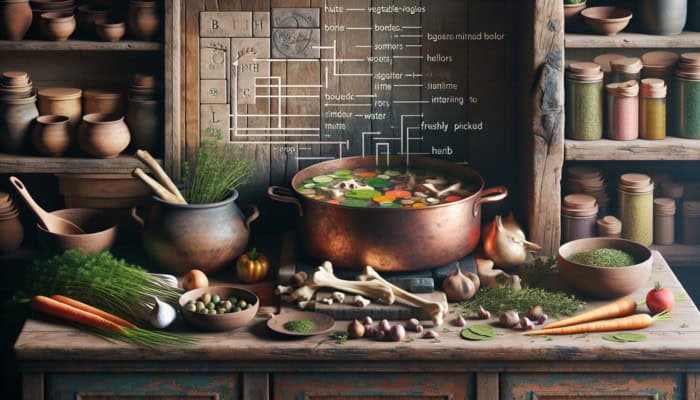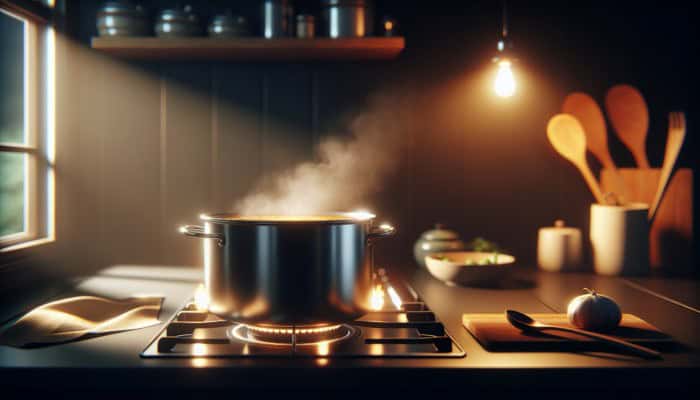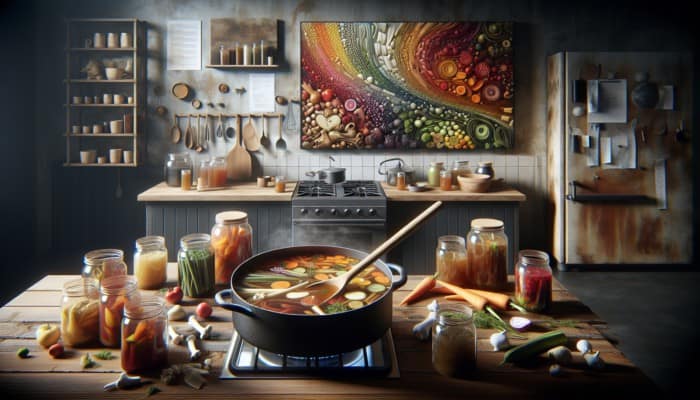Master the Art of Crafting Homemade Stock Using Kitchen Scraps
Creating your own homemade stock is an essential culinary skill that not only enhances the depth of your dishes but also promotes sustainability in your cooking practices. By learning how to make homemade stock from scraps, you not only boost the flavour profile of your meals but also minimise food waste, making it a beneficial practice for both your kitchen and the environment. Let’s explore the key essentials that will prepare you for a successful journey in stock-making.
Why Fresh Scraps Are Crucial for Quality Stock

The quality of your stock is profoundly influenced by the freshness of your ingredients. Using fresh scraps guarantees a rich and flavourful stock that serves as the perfect foundation for a myriad of dishes, ranging from hearty soups to flavourful sauces. Fresh vegetable scraps, such as onion skins, carrot tops, and celery leaves, impart vibrant flavours and essential nutrients, enhancing the overall taste. Similarly, fresh meat scraps, including bones and trimmings, yield a richer, more complex stock. Always strive to collect scraps from fresh produce and meats, as spoiled or wilted ingredients can adversely affect the taste and safety of your stock.
Essential Ingredients You Need to Create Stock
When it comes to making stock, simplicity is vital. The basic ingredients required include water, a variety of vegetables, and meat scraps. Water serves as the primary base, acting as the medium to extract flavours from your scraps. For vegetables, consider using commonly discarded items like onion skins, carrot peels, and garlic cloves. If you’re preparing meat stock, bones and trimmings from chicken, beef, or any other meat provide the essential backbone of flavour. Incorporating herbs such as parsley, thyme, or bay leaves can significantly enrich the aroma and taste of your stock, making it more delightful.
Understanding Cooking Time and Temperature for Optimal Stock
A critical factor in creating a successful stock is managing the cooking time and temperature. It’s essential to allow the stock to simmer gently for at least 2 hours at a low temperature. This slow cooking process enables the flavours to meld beautifully while extracting maximum nutrients from the scraps. Overheating can lead to a bitter taste and an unappealing cloudy appearance, so keep the heat low and maintain a gentle simmer throughout the process. For meat-based stocks, consider extending the cooking time to 4 hours or more, especially when using larger bones, to capture every bit of flavour.
Step-by-Step Guide to Making Homemade Stock from Scraps

Creating stock from scraps is a straightforward process that anyone can master. Follow this detailed step-by-step guide to ensure your stock is brimming with flavour and nutrients.
Gathering and Collecting Your Kitchen Scraps
Begin by accumulating vegetable and meat scraps over time. Keep a dedicated container in your fridge or freezer to store these scraps. This container can include onion peels, carrot tops, celery leaves, and any meat trimmings you may have. The beauty of this method is that you can gradually build up a collection of scraps, making stock-making a convenient and sustainable practice. Aim to gather enough to fill a large pot when you’re ready to craft your stock, ensuring you're prepared for the cooking process.
Preparing Your Pot for Stock-Making
Once you have gathered your scraps, it’s time to prepare your pot. Select a large pot capable of accommodating all your scraps and water without overflowing. A stockpot is ideal, but any large pot will do. Add your vegetable and meat scraps to the pot, ensuring a balanced mix for optimal flavour extraction. Fill the pot with cold water, covering the scraps by about an inch. Starting with cold water helps to extract the flavours more effectively during the cooking process, leading to a richer end product.
Simmering Your Stock for Maximum Flavour

Place your pot on the stove and bring it to a gentle boil. Once boiling, reduce the heat to low to maintain a gentle simmer, which is the most critical stage in making stock. Allow it to simmer for a minimum of 2 hours, stirring occasionally to prevent sticking at the bottom. For meat stocks, consider simmering for 4 hours or longer. As the stock simmers, you’ll notice it taking on a beautiful golden hue while a rich aroma fills your kitchen. This slow simmering allows the flavours to meld, resulting in a delicious and nutritious base for your culinary creations.
Straining Your Stock for Clarity and Taste
After the simmering process, it’s time to strain the stock. Carefully remove the pot from the heat and let it cool slightly. Using a fine mesh strainer or a cheesecloth, strain the stock into another pot or bowl, discarding the solids. This crucial step ensures clarity and a refined flavour. If you desire a clearer stock, consider straining it multiple times. Once strained, allow the stock to cool completely before storing it in the fridge or freezer to maintain its freshness and flavour.
Discover the Advantages of Using Kitchen Scraps for Homemade Stock
Making stock from scraps is not just a sustainable practice; it brings a wealth of benefits that make it a smart choice for any home cook looking to elevate their culinary skills.
Save Money and Reduce Food Waste
Utilising scraps greatly diminishes food waste and saves you money. Instead of purchasing pre-made stock or broth, you can create your own using ingredients that would otherwise be discarded. This frugal approach is especially advantageous for those on a budget or anyone aiming to be more mindful of their grocery spending. By repurposing scraps, you ensure that every part of your food contributes to a delicious meal, making your cooking practices more economical and efficient.
Enhance Nutritional Value in Your Dishes
Another significant advantage of creating stock from scraps is the added nutritional value that comes with it. Vegetable scraps often contain vitamins and minerals that can boost the health benefits of your stock. For example, carrot tops are rich in vitamin C and dietary fibre, while onion skins are a source of antioxidants. Furthermore, meat scraps, particularly bones, are packed with collagen, which is beneficial for joint health. Consequently, the stock you create becomes not only a flavour enhancer but also a nutritious addition to your meals.
Make a Positive Environmental Impact
Utilising scraps for homemade stock plays a significant role in reducing landfill waste, making it an environmentally-friendly choice. By making the most of your food, you contribute to a more sustainable kitchen while lowering your overall carbon footprint. This practice encourages a mindset of resourcefulness and sustainability that can extend beyond the kitchen. By sharing your stock-making journey with others, you can inspire a movement towards reducing food waste in your community, promoting sustainable cooking practices that benefit everyone involved.
Identifying the Best Types of Scraps for Flavourful Stock
Selecting the right scraps is essential for crafting a delicious and aromatic stock. Here’s a breakdown of the best types of scraps to use for optimal flavour extraction.
Maximise Flavor with Vegetable Scraps
Vegetable scraps form the cornerstone of a flavourful stock. Ingredients like onion skins, carrot tops, garlic cloves, and celery leaves are among the best options to consider. These ingredients contribute depth and sweetness to your stock, creating a robust base for soups and sauces. Additionally, you can incorporate herbs like parsley stems, thyme, and bay leaves to infuse your stock with aromatic qualities. Experimenting with different combinations allows you to discover your preferred flavour profile, ensuring that your stock is both unique and delicious.
Creating Richness with Meat Scraps
For those aiming to produce a rich meat stock, incorporating bones and meat trimmings is essential. Chicken carcasses, beef bones, and pork scraps work beautifully, providing a depth of flavour that vegetable scraps alone cannot achieve. Roasting the bones before adding them to your stock can intensify their flavour, adding a caramelized note to your final product. The collagen released from the bones during simmering also adds body and richness to your stock, making it an indispensable component for hearty soups and stews.
Enhancing Taste with Herb Scraps
Herb scraps, though often overlooked, can elevate your stock to new heights. Stems from fresh herbs like parsley, cilantro, and thyme add a fragrant aroma that enhances the overall taste of your stock. You can also experiment with robust herbs like rosemary or sage to impart a different character to your stock. Remember, balancing the flavours is key, so use herb scraps judiciously to avoid overpowering the other ingredients.
Effective Strategies for Storing and Freezing Homemade Stock
Once you’ve successfully crafted your stock, proper storage is crucial to maintaining its freshness and flavour. Here are some effective strategies for storing and freezing your homemade stock.
Rapid Cooling Methods for Stock
Before storing your stock, it’s essential to cool it quickly to prevent bacterial growth. Divide the hot stock into smaller portions in shallow containers, which will help facilitate faster cooling. Additionally, you can place the containers in an ice bath to expedite the cooling process. Once the stock reaches room temperature, transfer it to the fridge if you plan to use it within a few days, or proceed to freeze it for longer-term storage.
Freezing Stock in Convenient Portions
Freezing your stock in manageable portions is an excellent way to ensure you always have it on hand when needed. Ice cube trays are perfect for this purpose; simply pour the cooled stock into the trays, freeze, and then transfer the cubes to a freezer bag. This method allows you to defrost just the right amount for your recipes, significantly reducing waste and ensuring that your stock retains its quality over time.
Importance of Labelling and Dating Frozen Stock
Always label and date your frozen stock to keep track of its freshness. This simple yet effective step can save you from the disappointment of discovering that your stock has been in the freezer for too long. Typically, homemade stock can be stored in the freezer for up to six months. After this period, the flavour may decline, so keep an eye on your inventory and use it within this timeframe for the best results.
Avoiding Common Mistakes When Making Stock
While making stock is relatively straightforward, there are common pitfalls that can lead to less-than-ideal results. Avoiding these mistakes will ensure that your stock is both delicious and nutritious.
The Risks of Overcooking Your Stock
One of the most frequent mistakes people make is overcooking the stock. While it may seem logical that a longer cooking time would yield a more flavourful stock, overcooking can actually lead to a bitter taste. Aim for a gentle simmer and keep a close watch on the cooking time. For vegetable stock, 2 to 3 hours is adequate, while meat stocks may require 4 hours or more. Trust the process and don’t rush it to achieve the best flavour possible.
Ensuring Freshness: Avoid Using Spoiled Scraps
Another critical mistake is using spoiled scraps, which can ruin the flavour of your stock and pose safety risks. Always inspect your vegetable and meat scraps before adding them to the pot. If any scraps show signs of spoilage, it’s best to discard them rather than risk compromising the quality of your stock. Freshness is vital, so be diligent when selecting your ingredients to ensure a safe and tasty outcome.
The Importance of Skimming Impurities from Stock
Failing to skim off impurities during the cooking process can result in a cloudy stock. As the stock simmers, various impurities will rise to the surface. Use a ladle or skimmer to remove these impurities, achieving a clearer, more refined stock. This step not only improves the appearance but also enhances the taste, making your stock more visually appealing and palatable.
Creative Culinary Recipes Using Your Homemade Stock
Once you’ve mastered the art of making stock from scraps, the next step is to put it to use in innovative recipes. Here are a few ideas to inspire your culinary creations.
Crafting Hearty Soups and Stews
Homemade stock serves as an exceptional base for hearty soups and stews. Whether you’re preparing a classic chicken soup or a robust beef stew, using your stock adds a depth of flavour that store-bought options simply cannot match. Experiment with different ingredients and spices to create a dish that showcases your unique tastes and culinary flair.
Elevating Sauces and Gravies with Stock
Enhance your sauces and gravies by incorporating the rich flavour of homemade stock. Whether you’re crafting a simple pan sauce or a complex gravy for a roast, substituting stock for water or store-bought broth will elevate your dish to new heights. The depth of flavour in your stock will shine through, making your sauces more robust and delicious, providing a delightful experience for your diners.
Infusing Flavour into Risotto and Rice Dishes
Using stock as the cooking liquid for risotto or rice dishes adds incredible depth of flavour. Instead of plain water, substitute your homemade stock for a richer and more satisfying meal. The stock will infuse the grains with flavour, ensuring each bite is a delight. This method works beautifully for any rice dish, from pilafs to paellas, enhancing the overall dining experience.
Using Stock for Braising Meats
Homemade stock is ideal for braising meats, providing both flavour and moisture for a tender result. Whether you’re braising beef, pork, or chicken, using your stock as the braising liquid guarantees that the meat absorbs all the delicious flavours. The result is a succulent dish that showcases the effort you put into making your stock, delighting everyone at your table.
The Positive Environmental Impact of Using Kitchen Scraps for Stock
Making stock from scraps is not only a practical cooking method but also carries significant environmental benefits. Here’s how your efforts in the kitchen can positively impact the planet.
Significantly Reducing Food Waste
By making stock from scraps, you’re actively contributing to reducing food waste. Every year, a staggering amount of food is discarded, which leads to landfill overflow and greenhouse gas emissions. By repurposing scraps that would otherwise go to waste, you’re making a conscious choice to minimise your impact on the environment while making the most of your resources.
Lowering Your Carbon Footprint
Every bit of food waste that ends up in a landfill contributes to your carbon footprint. By utilising scraps for homemade stock, you’re helping to lower your carbon emissions. The more we can do to reduce waste, the smaller our overall environmental impact becomes. This small change in your cooking habits can lead to significant improvements in sustainability, making a notable difference.
Promoting Sustainable Cooking Practices
Sharing your knowledge about making stock from scraps can inspire others to adopt sustainable cooking practices. By demonstrating how easy and beneficial it is to repurpose kitchen scraps, you encourage a culture of mindfulness around food consumption. This ripple effect can lead to broader community actions aimed at reducing food waste and promoting sustainability, creating a more responsible approach to cooking.
Fostering Community Benefits Through Sustainable Cooking
Lastly, discussing your stock-making tips and experiences within your community can foster a sense of shared responsibility toward sustainability. Encouraging neighbours and friends to adopt similar practices can create a supportive network focused on reducing waste and embracing sustainable cooking. This collective effort can lead to a more environmentally conscious community, benefitting everyone involved and promoting a culture of sustainability.
Frequently Asked Questions (FAQs)
Can I use any vegetable scraps for stock?
You can utilise many vegetable scraps, but focus on flavourful options like onion skins, carrot tops, and celery leaves. Avoid using bitter vegetables or those that may spoil quickly, as they can negatively affect the taste of your stock.
How long can I store homemade stock in the fridge?
Homemade stock can typically be safely stored in the fridge for up to 3-4 days. If you don’t plan to use it within that timeframe, freezing is recommended for longer-term preservation.
Is it safe to use meat scraps for stock?
Yes, using fresh meat scraps, bones, and trimmings is safe and adds richness to your stock. Ensure they are fresh and properly handled to avoid any food safety issues.
Can I make stock without meat?
Absolutely! Vegetable stock can be just as flavourful and nutritious as meat stock. Focus on using a variety of vegetables and herbs to create a depth of flavour that satisfies your taste buds.
What’s the best way to thaw frozen stock?
The best way to thaw frozen stock is to transfer it to the fridge the night before you plan to use it. You can also thaw it in a microwave or by placing the container in warm water, ensuring it’s ready for your cooking needs.
Can I reuse scraps for stock?
While you can reuse some vegetable scraps, they may lose flavour after the first batch. It’s best to use fresh scraps for optimal results in subsequent batches to maintain the quality and taste of your stock.
How do I know if my stock has gone bad?
If your stock develops an off smell, unusual colour, or any signs of mould, it’s best to discard it. Always trust your senses to ensure food safety and quality.
Can I add spices to my stock while cooking?
Yes! Adding spices like peppercorns, bay leaves, and herbs while cooking can enhance the flavour of your stock. Just remember to strain them out before storing to maintain a clear stock.
Is homemade stock more nutritious than store-bought?
Homemade stock often contains more nutrients and flavour than store-bought options, as you control the ingredients and can include nutrient-rich scraps that enhance the final product.
Can I make stock in a slow cooker?
Yes, making stock in a slow cooker is an excellent option. Simply add your scraps and water, set it on low, and let it simmer for several hours for a rich and flavourful stock.



Your exploration of crafting homemade stock from kitchen scraps certainly hit home for me. It’s refreshing to see a focus on not only elevating our culinary skills but also embracing sustainability—an area where many of us can certainly improve. It’s a delicate balance, isn’t it? On one hand, we’re motivated by the desire to create delicious meals, and on the other, we’re grappling with the reality of food waste.
It’s great to see that the topic resonated with you. The balance between creating delicious meals and managing food waste can certainly feel daunting. One approach that helps is to think of every part of the ingredient as having potential. For example, vegetable peels, herb stems, and chicken bones can all contribute to a flavorful stock. Not only does this practice elevate our dishes, but it also makes a tangible difference in reducing waste.
I’m so glad to hear that you resonated with the article! If you’re interested in exploring more ways to minimize food waste while enhancing your cooking, check out this resource that dives deeper into sustainable cooking practices.
https://cookinggods.com/DigestiveHealth
I really appreciate the focus on using fresh scraps to make stock, as it beautifully aligns with a more sustainable approach to cooking. It’s fascinating how something as simple as saving vegetable peels and tops can lead to such a flavorful outcome. I remember a time when I started saving my scraps — it felt like a small shift, but it transformed my kitchen practices.
It’s great to hear you’ve had a similar experience! Saving vegetable scraps does seem like a small shift, but it really opens up new possibilities in the kitchen. I find it interesting how every little piece has its own flavor story, like the way onion skins can give stock a lovely color or how herb stems pack a punch. Have you experimented with different combinations yet? It can be fun to toss in what you have on hand and see what flavors emerge. Plus, it feels nice knowing that you’re making the most out of your ingredients while reducing waste. What’s been your favorite thing to make with your homemade stock?
I truly appreciate this insightful exploration of crafting homemade stock from kitchen scraps. It resonates with my ongoing journey towards zero waste in cooking. I’ve found that making stock not only enhances the flavor of my dishes but also connects me to the ingredients I use in a meaningful way.
Your insights on using kitchen scraps for stock resonate deeply with me, particularly in today’s context of reducing food waste and adopting more sustainable cooking practices. I’ve recently started saving not just vegetable scraps, but also herb stems and even bones from meals to create a rich, complex broth. This method not only amplifies the flavors of my dishes but also acts as a reminder of the importance of mindful cooking.